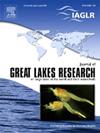Seasonal population characteristics and gut contents of the invasive mysid, Hemimysis anomala, in Milwaukee Harbor, Lake Michigan
IF 2.5
3区 环境科学与生态学
Q3 ENVIRONMENTAL SCIENCES
引用次数: 0
Abstract
The invasive mysid, Hemimysis anomala, is abundant along harbor breakwalls in Lake Michigan, forming large swarms, but we know little of its population dynamics or diet in these novel environments. We examined abundance, body length, and sex/developmental stage in animals collected using lighted funnel traps in Milwaukee Harbor, WI, from summer 2021 to spring 2022. We applied novel immunochemical analysis to examine gut contents using purified polyclonal antisera raised against nine putative zooplankton prey (Bosmina longirostris, Bythotrephes longimanus, Cercopagis pengoi, Daphnia galataea mendotae, Daphnia pulex, Dreissena veliger larvae, Keratella cochlearis, Leptodiaptomus ashlandii, and Limnocalanus macrurus). Population dynamics differed from those described in other Great Lakes; mid-late summer populations were dominated by juveniles (< 6 mm), and small (∼7 mm) adult males (80–90 %) with few reproductive females (5–10 %). Males did not die after reproducing and adults grew through winter (0.011–0.015 mm d−1), reaching 10–12 mm by early spring. Immunochemical gut analyses showed Hemimysis to be generalist feeders, consuming all nine species tested. Most trapped individuals (58 %) had empty guts, suggesting that Hemimysis cleared their guts before recovery. No differences in diet were seen among sexes/developmental stages, or across seasons. We also compared Hemimysis directly sampled from pelagic swarms, to those recovered from benthic traps. There were no differences in size or sex/developmental stage of individuals between traps and swarm populations, refuting the idea that swarming serves a reproductive function, but there were differences in prey found in guts between individuals in swarms and from traps, suggesting swarming is associated with feeding.
密根湖密尔瓦基港侵袭性粘蝇(Hemimysis anomala)的季节种群特征及肠道内容物
在密歇根湖的港口防波堤上,大量存在着一种名为Hemimysis anomalala的侵入性mysid,形成了庞大的群体,但我们对这些新环境下的种群动态或饮食知之甚少。从2021年夏季到2022年春季,我们在威斯康星州密尔沃基港使用轻型漏斗陷阱收集了动物的丰度、体长和性别/发育阶段。我们采用了一种新的免疫化学分析方法,利用纯化的多克隆抗血清检测肠道内容物,这些抗血清针对9种可能的浮游动物猎物(长鼻虫、长鼻虫、长鼻虫、长鼻虫、水蚤、水蚤、水蛭幼虫、耳蜗角虫、阿斯兰地Leptodiaptomus ashlandii和Limnocalanus macrurus)。人口动态与其他五大湖不同;夏中后期种群以幼鱼为主(<;6毫米),成年雄蚊体型小(~ 7毫米)(80 - 90%),繁殖性雌蚊很少(5 - 10%)。雄虫繁殖后不死亡,成虫在冬季生长(0.011 ~ 0.015 mm d−1),早春时达到10 ~ 12 mm。肠道免疫化学分析显示,小腹虫是一种多面手,能吃掉所有被测试的9种动物。大多数被困的个体(58%)的肠道是空的,这表明在恢复之前,空腹清理了他们的肠道。饮食在性别/发育阶段或季节之间没有差异。我们还比较了直接从深海群中取样的小腹虫和从底栖陷阱中恢复的小腹虫。陷阱和群体之间的个体在大小或性别/发育阶段没有差异,反驳了群体具有生殖功能的观点,但在群体和陷阱中的个体之间的内脏中发现的猎物存在差异,这表明群体与觅食有关。
本文章由计算机程序翻译,如有差异,请以英文原文为准。
求助全文
约1分钟内获得全文
求助全文
来源期刊

Journal of Great Lakes Research
生物-海洋与淡水生物学
CiteScore
5.10
自引率
13.60%
发文量
178
审稿时长
6 months
期刊介绍:
Published six times per year, the Journal of Great Lakes Research is multidisciplinary in its coverage, publishing manuscripts on a wide range of theoretical and applied topics in the natural science fields of biology, chemistry, physics, geology, as well as social sciences of the large lakes of the world and their watersheds. Large lakes generally are considered as those lakes which have a mean surface area of >500 km2 (see Herdendorf, C.E. 1982. Large lakes of the world. J. Great Lakes Res. 8:379-412, for examples), although smaller lakes may be considered, especially if they are very deep. We also welcome contributions on saline lakes and research on estuarine waters where the results have application to large lakes.
 求助内容:
求助内容: 应助结果提醒方式:
应助结果提醒方式:


